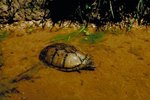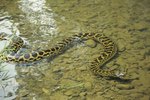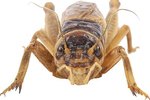
Though the adults are one of the largest tortoise species in the world, hatchling and juvenile African spur tortoises (Geochelone sulcata) are small, adorable and personable tortoises. Unfortunately, this causes many people to purchase them impulsively without considering the accommodations their new pet will eventually require. While you can house young animals inside, adult spur tortoises require large, outdoor enclosures with warm temperatures year-round.
The Great Outdoors
African spur tortoises reach very large sizes -- large individuals may exceed 100 pounds in weight, and have carapaces of 30 inches in length. Adults require at least 60 square feet of space, and twice or thrice this much space is even better; so, in most cases outdoor accommodations are the only realistic option. This is only possible if you live in an area with a suitably warm and dry climate.
Indoor Nursery
Young African spur tortoises are fairly easy to house. Young animals require about 4 square feet of space, but you must provide them with more space as they grow. Aquariums, livestock troughs, plastic storage boxes or commercial reptile cages make suitable housing for the first four or five years; after that most African spur tortoises will exceed 12 inches in length, making indoor accommodations impractical. It is best to invest in the largest size indoor cage you can afford at the outset -- otherwise, you must purchase several new cages as your tortoise grows. As long as your tortoise has access to good hiding spots, extremely large cages are not problematic.
Competing with the Sun
Hailing from equatorial Africa, spur tortoises require very warm and dry conditions. In captivity, you must ensure that your tortoise has access to appropriate basking temperatures. Spur tortoises require basking areas with surface temperatures of approximately 100 degrees -- if this is not possible via sunshine alone, you must include basking lights in their outdoor enclosures. Additionally, African spur tortoises produce vitamin D3 when exposed to sunlight, which is necessary for calcium absorption. Tortoises reared indoors must have access to full spectrum lighting -- including the UVB portion of the spectrum -- at their basking spot. Do not mist your tortoise’s cage and keep the enclosure dry; while he will obtain most of his water needs from his food, provide a shallow pan of clean water at all times.
Tunneling to Freedom
A wide variety of outdoor habitat designs are appropriate, though all must share a few common elements. Enclosure walls must be very strong to prevent the massive tortoises from destroying them. Large stones, poured concrete walls, chain-link fence and wood are common choices, though each has pros and cons. Spur tortoises are incredible excavators and you must prevent them from tunneling out of their cages. The walls of the enclosure can be set at least 3 feet deep or you can install a subterranean floor throughout the cage such that the tortoises will hit an impenetrable barrier once they have dug about 2 feet deep.
Predator Protection
While large adults are safe from most other animals, it is important to protect small tortoises from pets and predators. A screen or chain-link fence roof is a good idea for outdoor cages. Indoors, you can construct a custom lid from window screen and a wooden frame. Additionally, for your tortoise’s well-being, provide him with a few hiding locations. Bark, hollow logs or commercial hiding spots work for juveniles, while modified dog houses are more appropriate for adults.
References
Photo Credits
-
Chad Baker/Jason Reed/Ryan McVay/Photodisc/Getty Images



